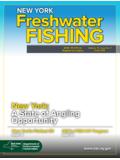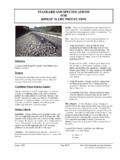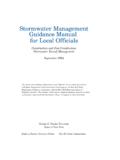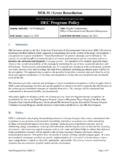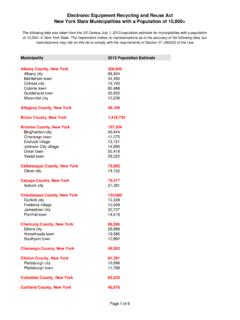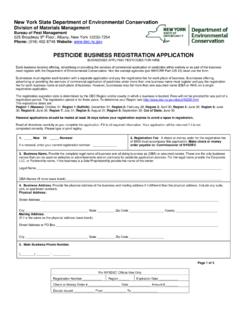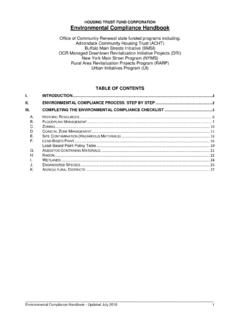Transcription of THE DEC POLICY SYSTEM
1 New York StateDepartment of Environmental ConservationTHE DEC POLICY SYSTEMPROGRAM POLICYD epartment ID:DEP-00-2 Program ID:n/aTitle: Assessing and Mitigating Visual ImpactsIssuing Authority: Article 8, 49 Originating Unit: Division of EnvironmentalPermits Name: Jeffrey SamaOffice/Division: Environmental Permits Title: DirectorUnit:Signature: /s/Date: 7/31/00 Phone: (518) 402-9167 Issuance Date: 7/31/00 Latest Review Date (Office Use):Abstract: Facilities regulated by the Department of Environmental Conservation located in visualproximity to sensitive land uses can produce significant visual impacts. This POLICY and guidance defineswhat visual and aesthetic impacts are, describes when a visual assessment is necessary and how toreview a visual impact assessment, differentiates State and local concerns, and defines avoidance,mitigation and offset measures that eliminate, reduce, or compensate for negative visual effects.
2 Aglossary of terms is provided for reference. I. PurposeThis memorandum provides direction to Department staff for evaluating visual and aesthetic impactsgenerated from proposed facilities. This guidance defines State regulatory concerns and separates themfrom local concerns. There is nothing in this program POLICY that eliminates or reduces the responsibilityof an applicant to local agencies to address local visual or aesthetic concerns. In addition, this programpolicy does not relieve applicants from requirements of other State agencies, such as Department of StateCoastal Zone Program or Department of Public Service. This guidance will also define importanttechnical concepts and provide a mechanism for complying with the balancing provisions of the StateEnvironmental Quality Review Act (SEQR) with respect to environmental aesthetics.
3 II. BackgroundAn ever expanding body of research has demonstrated that environmental aesthetic values are sharedamong the general population. This research finds that such values are not idiosyncratic, random, orarbitrary. For example, millions of people visit Niagara Falls for our shared appreciation of its places have been recognized for their beauty and designated through Federal or State democraticpolitical processes, reinforcing the notion that environmental aesthetic values are shared. Recognition ofaesthetic resources also occurs at local levels through zoning, planning or other public means. Thatthese special places are formally recognized is a matter of public record. This guidance contains 31, 2000generic listing of all aesthetic resources of statewide significance and serves as the template from whichaesthetic issues of State concern can be distinguished from local issues.
4 Generally, it is staff sresponsibility to identify and mitigate impacts to Federal and State designated aesthetic resources. Withrespect to local resources, Department staff should defer to local decision makers, who are likely to bemore familiar with and best suited to address them. III. PolicyIn the review of an application for a permit, Department staff must evaluate the potential for adversevisual and aesthetic impacts on receptors outside of the facility or property. When a facility ispotentially within the viewshed of a designated aesthetic resource, the Department will require a visualassessment, and in the case where significant impacts are identified, require the applicant to employreasonable and necessary measures to either eliminate, mitigate or compensate for adverse aestheticeffects. IV. ResponsibilityThe environmental analyst, acting as project manager, for review of a new application must assure that visual and aesthetic impacts are properly evaluated by the applicant.
5 For new permits or significantlymodified permits, staff must determine the potential significance of the action pursuant to the review of an application for a permit, staff must evaluate the potential for adverse aestheticimpacts to sensitive places. Sensitive places of statewide concern are listed in this guidance (see ). From the State s perspective there may be a significant impact if one or more of the listedplaces lies within the viewshed of a proposed project. From a local perspective there may be a significantimpact if a local resource lies within the project s viewshed. This simple concept may help staff anddecision makers distinguish local concerns from State concerns, and public concerns from individualexpressions of respect to aesthetics, an individual citizen s expression of concern is usually based on the beliefthat a property or particular "neighborhood" lies within the viewshed of a proposed project.
6 This isdifferent from the concerns of the public at large which has a stake in aesthetic resources recognized ashaving designated value under the public domain. Significant impacts are identified and confirmed by staff during the review of an application. SEQR obligates the Department to mitigate such impacts to the maximum extent practicable [6 NYCRR (d)(5)]. Local involved agencies must do the same with respect to local resources and likewisecomply with Article 8 of the ECL and 6 NYCCR Part 617. Impacts to aesthetic resources of statewideconcern may require more substantial mitigation strategies to achieve project approval. Mitigation costsand practicality of the mitigative measures must be weighed in the balancing required by the StateEnvironmental Quality Review Act. Local resources are frequently designated through local zoning and planning processes.
7 Accordingly,local jurisdictions may require additional and somewhat different information than the Department. Thelegislature has recently recognized and addressed this jurisdictional difference. In 1999, the Legislature,revised Article X of the Public Service Law to eliminate a DEC requirement to testify on behalf of 31, 2000jurisdictions concerning the impacts of power plant siting. In doing so, they explicitly eliminated therequirement that DEC staff testify with regard to local jurisdictional ProcedureStaff must assure that the full scope of visual and aesthetic concerns are addressed. This includesimpacts from all project components and their operation on all inventoried resources. In addition, anequitable level of expectations between the potential significance of the impact, the degree ofsophistication of the analysis required of applicant and appropriate level of mitigation strategies must beestablished.
8 The goal of visual assessment is to reveal impacts and effective mitigation strategies. Smallscale, low budget projects should not be burdened with the costs of sophisticated visual analyses. Inthese instances, it is generally more effective to reserve applicant investments for mitigation rather thancomplex visual assessments. Simple line-of-sight profiles may suffice for revealing impacts andpotential mitigation strategies (see appendix A for an illustration of their use).Staff must take certain basic steps to assure that visual concerns have been fully addressed in eachapplication. Those steps are:A. Verify the applicant s inventory of aesthetic Verify the applicant s visual assessment, using either graphic viewshed and line-of-sight profileanalysis as illustrated in Appendix A, or more sophisticated visual simulations and digital viewshedanalysis, as Determine or verify the applicant s assessment of the potential significance of the Confirm that applicant s mitigation strategies are reasonable and are likely to be effective, orassure mitigation by requiring the applicant to submit a design that includes the required mitigation, or,impose permit conditions consistent with those mitigation discussion of each follows:A.
9 Inventory of Aesthetic is important to note that all significant scenic and aesthetic resources may not have yet been designatedin New York State. However, for the purposes of this POLICY all aesthetic resources of statewidesignificance may be derived from one or more of the following categories:1) A property on or eligible for inclusion in the National or State Register of Historic Places [16 470a et seq., Parks, Recreation and Historic Preservation Law Section ]; Trinity Church inManhattan, Schuyler Mansion in Albany; 2) State Parks [Parks, Recreation and Historic Preservation Law Section ]; Grafton Lakes StatePark, Rensselaer County;3) Urban Cultural Parks [Parks, Recreation and Historic Preservation Law Section ];1 State Coastal Policies number 24 and 25 derived in part from Section 912 of Article 42 of theExecutive Law define the criteria that, when properly employed, assure project consistency with coastalzone management objectives.
10 Such policies are consistent with the review mechanisms contained in thisDEC POLICY . Also for reference is the July 1993 DOS SASS publication for Columbia-Greene, Catskill-Olana, Estates District, Ulster North, Esopus-Lloyd, and the Hudson 31, 20004) The State Forest Preserve [NYS Constitution Article XIV]; Adirondack and Catskill Parks;5) National Wildlife Refuges [16 668dd], State Game Refuges and State Wildlife ManagementAreas [ECL 11-2105]; Montezuma National Wildlife refuge; Perch River Wildlife ManagementArea, Jefferson County;6) National Natural Landmarks [36 CFR Part 62]; Iona Island Marsh, Hudson River, RocklandCounty;7) The National Park SYSTEM , Recreation Areas, Seashores, Forests [16 1c]; GatewayNational Recreation Area, Staten Island; Finger Lakes National Forest, Schuyler County.

